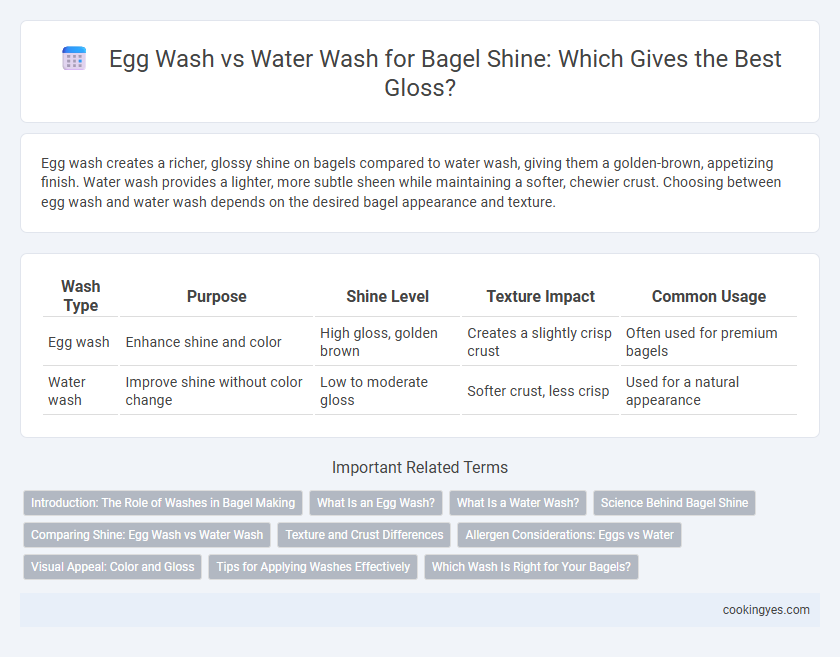Egg wash creates a richer, glossy shine on bagels compared to water wash, giving them a golden-brown, appetizing finish. Water wash provides a lighter, more subtle sheen while maintaining a softer, chewier crust. Choosing between egg wash and water wash depends on the desired bagel appearance and texture.
Table of Comparison
| Wash Type | Purpose | Shine Level | Texture Impact | Common Usage |
|---|---|---|---|---|
| Egg wash | Enhance shine and color | High gloss, golden brown | Creates a slightly crisp crust | Often used for premium bagels |
| Water wash | Improve shine without color change | Low to moderate gloss | Softer crust, less crisp | Used for a natural appearance |
Introduction: The Role of Washes in Bagel Making
Egg wash and water wash play distinct roles in achieving the signature shine and texture of bagels. Egg wash, rich in protein and fat, creates a glossy, golden crust that enhances both appearance and flavor. Water wash produces a subtle sheen while maintaining a classic chewy exterior, offering a traditional finish to bagels.
What Is an Egg Wash?
An egg wash is a mixture of beaten eggs, sometimes combined with water or milk, applied to bagel dough before baking to create a glossy, golden-brown crust. The proteins and fats in the egg wash enhance the bagel's shine and color, making it more visually appealing than a water wash. Using an egg wash results in a richer, more attractive finish, while a water wash produces a less shiny, matte crust.
What Is a Water Wash?
A water wash is a simple technique where bagels are brushed with plain water before baking to create a subtle, natural shine without altering flavor or texture. Unlike egg wash, which contains proteins and fats that enhance gloss and color, water wash primarily promotes a light sheen and helps develop a slightly crisp crust. This method is ideal for achieving a traditional, understated appearance while maintaining the bagel's authentic taste.
Science Behind Bagel Shine
Egg wash creates a glossy, golden shine on bagels due to the proteins and fats reacting with heat through the Maillard browning process, enhancing flavor and appearance. Water wash results in a subtle sheen by hydrating the surface starches, which gelatinize during baking but lack the browning effect. The science behind bagel shine hinges on protein and sugar interactions in egg wash versus simple starch hydration in water wash, impacting texture and color intensity.
Comparing Shine: Egg Wash vs Water Wash
Egg wash creates a rich, golden shine on bagels due to the proteins and fats that caramelize during baking, enhancing both appearance and flavor. Water wash produces a subtler, matte finish without the added gloss, resulting in a more traditional, less shiny crust. For a pronounced, glossy exterior, egg wash is preferred, while water wash suits those seeking a more natural, understated sheen.
Texture and Crust Differences
Egg wash on bagels produces a glossy, golden-brown crust with a slightly firmer texture, enhancing visual appeal and adding a subtle richness. Water wash results in a matte finish with a softer crust, allowing the natural flour dusting to remain visible and providing a chewier bite. Choosing between egg wash and water wash directly influences the bagel's shine, crust crunchiness, and overall mouthfeel.
Allergen Considerations: Eggs vs Water
Egg wash provides a glossy, golden finish to bagels but contains egg proteins that may trigger allergies or dietary restrictions, making it less suitable for sensitive individuals. Water wash, free from allergens, delivers a subtle shine without introducing common allergens, offering a safer alternative for those with egg allergies or vegan preferences. Choosing between egg wash and water wash depends on balancing desired appearance with allergen management and consumer safety.
Visual Appeal: Color and Gloss
Egg wash enhances bagel shine by producing a rich, golden-brown color and a glossy, appetizing surface due to its protein and fat content reacting with heat. Water wash creates a more subtle shine with a lighter, matte finish, resulting in a softer crust appearance but less color intensity. Choosing egg wash maximizes visual appeal for bagels, making them more attractive to consumers through deeper color and pronounced gloss.
Tips for Applying Washes Effectively
Applying egg wash to bagels creates a glossy, golden crust due to the protein and fat content that promotes browning during baking. Water wash produces a subtle sheen and softer texture by helping the dough surface retain moisture without additional browning. For optimal results, use a brush to apply an even layer of egg wash just before baking and avoid over-applying to prevent a soggy crust, while water wash should be applied before boiling to enhance shine without altering flavor.
Which Wash Is Right for Your Bagels?
Egg wash creates a glossy, golden finish on bagels by adding protein and fat that brown during baking, enhancing both appearance and flavor. Water wash produces a subtle shine with a thinner crust, allowing the bagel's natural texture and toppings to stand out without altering taste. Choosing between egg wash and water wash depends on whether you prefer a rich, eye-catching crust or a more traditional, understated bagel surface.
Egg wash vs Water wash for bagel shine Infographic

 cookingyes.com
cookingyes.com